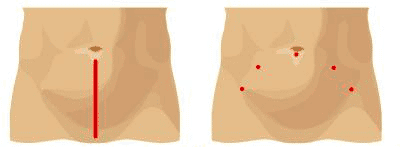Less invasive surgery
The video below is from the manufacturers of the robotic surgery device.
One of the problems with prostate surgery in the past has been that the prostate is very difficult for a surgeon to access without doing a considerable amount of damage to surrounding tissue and nerves. In particular, the damage to nerves is what has caused many of the post-surgical side-effects — incontinence, loss of sexual function, and so on.
Advances in robotic surgery devices over the past decade have lead to improvement in recovery after prostate cancer surgery.
Under the control of a good surgeon, the tiny arms of the robot are able to perform extremely sensitive procedures in the tight confines of the pelvis.
A good demonstration of the delicacy of the robot can be seen in the video below, where a skilled surgeon uses the robot to peel a grape.
Smaller incisions
Previously, prostate surgery required a large incision from the navel to the groin, or across the lower abdomen. The robotic surgery requires just five or six small incisions for the robotic micro-instruments to be inserted.

The image on the left shows the long incision previously required. The new robotic surgery require just five or six small cuts.
Better outcomes
Each individual case of of prostate cancer is different, and specific outcomes cannot be predicted. Your case may not even be suitable for robotic surgery. Your surgeon’s skill, technique and experience is most important in the outcome following prostate surgery, whether by open or robotic techniques.
That said, when looking at the overall picture of robotic prostate surgery versus conventional prostate surgery, there is increasing evidence that the robotic surgery improves outcome in terms of post-surgical side-effects.
Some of that evidence is available on the manufacturer’s site.
At the Royal Brisbane Hospital we are performing one of the world’s first clinical trials on open vs. robotic surgery and I am one of the surgeons along with Dr Geoff Coughlin involved in this trial. This trial, led by Professor Frank Gardiner, will answer some of the questions regarding the potential advantages of robotic surgical techniques on overall outcome.

